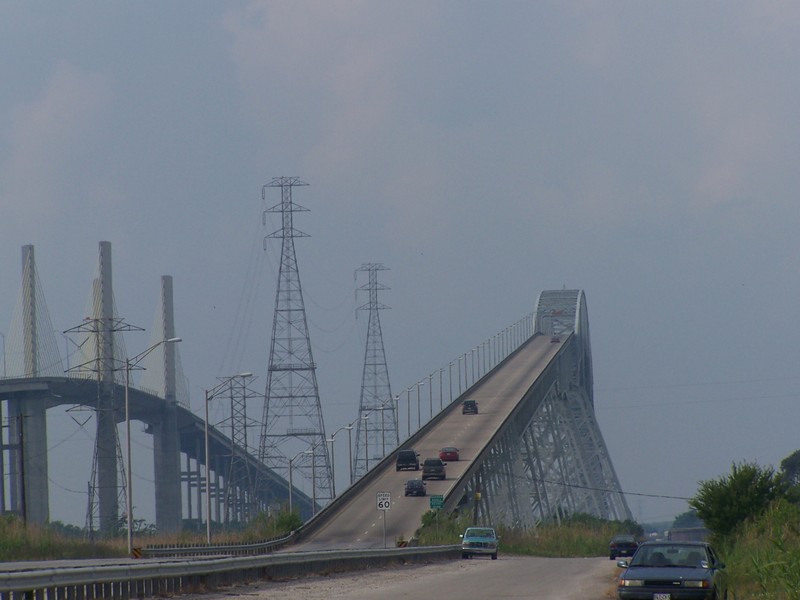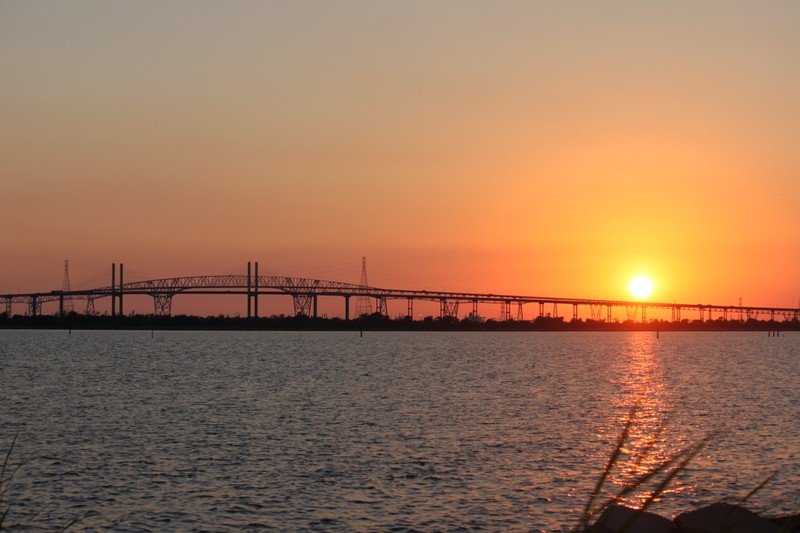Rainbow Bridge
Introduction
Text-to-speech Audio
The construction of the Rainbow Bridge was the topic of much debate between the city of Beaumont and Port Arthur. However, it's construction was compromised, and what was built is the tallest bridge in the state of Texas. The bridge was built during the years of 1936 and 1938.
Images
"RainbowBridge (Texas)" by Aren Cambre Original uploader was Novasource at en.wikipedia

"Rainbow Bridge Sunset" by Blakemul - canon t1i. Licensed under CC BY-SA 3.0 via Wikimedia Commons - https://commons.wikimedia.org/wiki/File:Rainbow_Bridge_Sunset.jpg#/media/File:Rainbow_Bridge_Sunset.jpg

Backstory and Context
Text-to-speech Audio
When the ferry failed to be an adequate means of transversing the Neches River, the construction of a bridge connecting Beaumont and Port Arthur was proposed. However, there was much disagreement between the two communities. Beaumont opposed the construction for they didn't think the bridge would be used much and it also worried them that since its dock was upstream the bridge would interfere with water navigation. Port Arthur, on the other hand, contested that the bridge would be beneifical because is would allow road traffic to flow freely between the two communities at all hours.
An agreement was reached in October of 1934. Beaumont said they would let go of the argument if Port Arthur would agree that the bridge would be constructed with a clearance of 185 feet; it was eventually compromised that the bridge's clearance would be 176 feet. This would make the bridge the highest highway bridge over tidal waters in the world and the tallest in the state. The debate over the clearence was important because there needed to be enough room for the tallest ship at the time, the USS Patoka, to go under. However, Patoka never has sailed the Neches and no ship has ever had any trouble passing under Rainbow Bridge.
The bridge is 7,700 feet long and 230 feet high with a 5 percent grade. Originally, the bridge was called the Neches River Bridge, but it was known differently depending on the county. For example, in Jefferson County, the bridge was known as the Orange Bridge and in Orange County, it was known as the Port Arthur Bridge. However, in 1957, the bridge got its present name: the Rainbow Bridge. The North Port Arthur Lions Club hosted a contest in order to name the bridge. A six-year-old girl named Christy McClintock (now, Loupe) submitted the name Rainbow Bridge because, as she told her grandfather, it "looked like a mechanical rainbow." She won the honor of naming the bridge as well as a $50 savings bond.
An agreement was reached in October of 1934. Beaumont said they would let go of the argument if Port Arthur would agree that the bridge would be constructed with a clearance of 185 feet; it was eventually compromised that the bridge's clearance would be 176 feet. This would make the bridge the highest highway bridge over tidal waters in the world and the tallest in the state. The debate over the clearence was important because there needed to be enough room for the tallest ship at the time, the USS Patoka, to go under. However, Patoka never has sailed the Neches and no ship has ever had any trouble passing under Rainbow Bridge.
The bridge is 7,700 feet long and 230 feet high with a 5 percent grade. Originally, the bridge was called the Neches River Bridge, but it was known differently depending on the county. For example, in Jefferson County, the bridge was known as the Orange Bridge and in Orange County, it was known as the Port Arthur Bridge. However, in 1957, the bridge got its present name: the Rainbow Bridge. The North Port Arthur Lions Club hosted a contest in order to name the bridge. A six-year-old girl named Christy McClintock (now, Loupe) submitted the name Rainbow Bridge because, as she told her grandfather, it "looked like a mechanical rainbow." She won the honor of naming the bridge as well as a $50 savings bond.
Sources
https://tshaonline.org/handbook/online/articles/err03
http://www.bridgecitytex.com/bc-bridgehist-114.php
